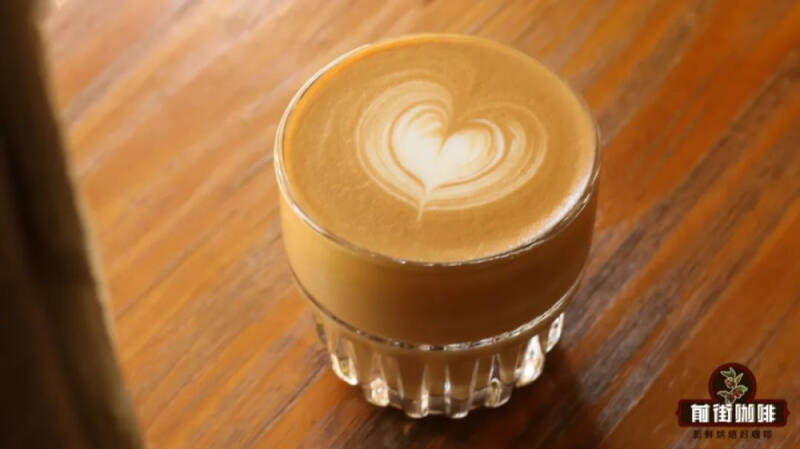How is "Ristretto", as the base of Australia White, made?

"Australian White" is a small exquisite milk coffee. Because of its rich and sweet chic experience, it is widely loved by all the major "cakes". And it is different from the key ingredients of latte and Cabo. In addition to the delicate and light milk foam, this delicacy is inseparable from Australia White's base-"Ristretto".

Because, the Ristretto production method that is widely rumored on the Internet is really too! More! La! The rookies are so confused that they can't really understand the meaning of Ristretto extraction. Therefore, Qianjie is going to talk about this "Ristretto" today, what it is and how it is made.
What is Ristretto? The literal translation of "Ristretto" is "Risiteau", and it may be hard to imagine what a cup of coffee it is if you look at these two words alone. So we might as well take a look at its other aliases: "espresso" and "espresso". "
How is it? is it suddenly enlightened? These completely different words all refer to the same kind of coffee-"concentrated". However, "this concentration is not the other concentration". Ristretto is very niche, although it and Espresso belong to espresso extracted by espresso machine, but it is so small that in dozens of espresso, only Australia White is using it as a base. Almost all the espresso bases except Australia and White use Espresso! The reason is that the production method of Ristretto does not exist independently, but the extraction mode derived from the production method of Espresso later!
Ristretto itself also has a meaning of "limitation" in it, as the name implies: since it is the extraction method derived from Espresso, coupled with the word limit, we can understand that there are certain restrictions on the extraction of Espresso. This restriction does not mean to control any of its parameters, but to limit the substances it extracts in concentrated production. obvious! In the concentrated extraction of the most critical powder and liquid, can limit the extraction of substances must be the "liquid"! So, let's take a look at how this "liquid" is restricted.
The way Ristretto is made
At present, there are two main ways to extract Ristretto, one is to directly limit the amount of liquid produced by Espresso and not to allow it to extract the latter part of the substance. For example, Qianjie Espresso's solution is to use 20g of beans and take 30 seconds to extract the liquid weight of 40ml. Then, in order to make Ristretto, we need to abandon the extraction of the back segment, as long as the front and middle part of Espresso, that is, the 70%--28ml of the total amount of 40ml can be extracted.
The advantage of this extraction is to "pinch" the nodes from which a large number of bitter substances are released, so that the proportion of bitter substances is reduced, the proportion of sour and sweet substances is more, and coffee can highlight more sweetness! In addition, there are many similar extraction methods: for example, some coffee shops only extract 2x3 of the concentrated amount, or use a powder-to-liquid ratio of 1:1 to extract, and so on. So we don't have to stick to certain parameters, we just need to understand the principle, no matter which way is correct!
Then there is the second way: "control the flow rate of coffee liquid"! Through fine grinding to control the flow rate, so as to obtain a higher concentration of espresso! It is still the analogy of the former street's Espresso: using 20g of beans, it takes 30 seconds to extract the liquid weight of 40ml. If we want to make Ristretto, then we need to grind it fine, and then 20g of beans still take 30 seconds to extract 70% of the original total, that is, 28ml!
The advantage of this method of extraction is that it is concentrated at a high concentration by superposition. Compared with the former, this method makes it easier to distinguish Ristretto from Espresso. After all, a new extraction scheme is designed directly! The taste will also be thicker and more full-bodied than the former! However, when it comes to practicality, it has to be the former!
As mentioned at the beginning, most espresso is based on Espresso, and Ristretto is currently only widely used by Australia and White. If you want to follow the second method of production, then, in order to ensure that other Italian style and Australia white can be produced at the same time, the coffee shop must be equipped with an extra bean grinder, and it will take time and materials to grind, which will greatly increase the cost! It is impossible for a businessman to say that he only uses a bean grinder and then "jumps" repeatedly between rough grinding and fine grinding, which is not realistic (unless he drinks it himself). Therefore, instead of using the latter to give themselves a "professional" name, stores are more likely to use the extraction scheme of the former, which is not only convenient and delicious, but also can reduce loss.
-END-
Front Street Cafe
No. 10 Baoqian street, Yandun road, Dongshankou, Yuexiu district, Guangzhou, Guangdong province
Important Notice :
前街咖啡 FrontStreet Coffee has moved to new addredd:
FrontStreet Coffee Address: 315,Donghua East Road,GuangZhou
Tel:020 38364473
- Prev

Lucky bean-seeking team opens Indonesia station and will launch wet plane SOE
Luckin Coffee's team of bean hunters went to the producing area of Gayo on the Indonesian island of Sumatra to look for beans and introduced a wet planed coffee bean into the "SOE Little Black Cup" series, according to relevant media reports. November coincides with Indonesia's native Arabica coffee.
- Next

If you drink take-out coffee on the spot, you will be charged a meal fee?!
▲ Click to follow | Daily boutique Coffee Culture Magazine Coffee Workshop for today's people, takeout has become an indispensable part of most people's lives. Many young people rely on takeout for three meals a day. However, today's takeout is not cheap either. Sometimes, in order to save the cost of three meals, customers always place an order before takeout.
Related
- What effect does Italian American coffee with filter paper have? Will coffee taste better if it is put on filter paper at the bottom of the powder bowl?
- What is the color difference in coffee beans? What are the characteristics of honey processed coffee beans? Why are the anaerobically treated coffee beans uneven in color?
- How does novice Xiaobai quickly get started and make coffee? Newbies learn to make coffee by hand and share the specific steps and process process!
- Costa tea has a shelf life of 100 years?! Expert: Unable to verify
- It's a huge uproar! American milk addition was rejected by Manner employees?!
- Mocha pot coffee bean recommendations| How fine and how much powder should be used for grinding? What parameter ratios do I need to use to make milk with Mocha pot coffee?
- What are the characteristics of the world's top ten coffee beans treated with Costa Rica honey? How to make black honey kadura from Tarazhu Pilon Processing Plant taste good?
- How to make deep-roasted coffee? What grinding water temperature does authentic Jamaica Blue Mountain No. 1 coffee use to brew it well?
- Selected high-grade rose summer coffee flavor tasting guide Why Panama rose summer has the aroma of flowers and fruits
- What equipment does a novice Xiaobai need to buy to learn to make coffee? Filter cup electronic scale bean grinder manual flushing pot purchase guide

